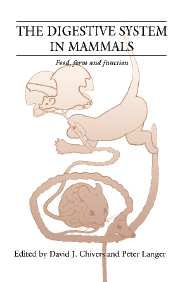Book contents
- Frontmatter
- Contents
- List of contributors
- Preface
- Part I Introduction
- Part II Food
- 5 Foods and the digestive system
- 6 Classification of foods for comparative analysis of the gastro-intestinal tract
- 7 The ‘carnivorous’ herbivores
- 8 Nutritional ecology of fruit-eating and flower-visiting birds and bats
- 9 Herbivory and niche partitioning
- 10 Taste discrimination and diet differentiation among New World primates
- 11 Potential hominid plant foods from woody species in semi-arid versus sub-humid sub-tropical Africa
- Part III Form
- Part IV Function
- Part V Synthesis and perspectives
- Index
9 - Herbivory and niche partitioning
Published online by Cambridge University Press: 18 March 2010
- Frontmatter
- Contents
- List of contributors
- Preface
- Part I Introduction
- Part II Food
- 5 Foods and the digestive system
- 6 Classification of foods for comparative analysis of the gastro-intestinal tract
- 7 The ‘carnivorous’ herbivores
- 8 Nutritional ecology of fruit-eating and flower-visiting birds and bats
- 9 Herbivory and niche partitioning
- 10 Taste discrimination and diet differentiation among New World primates
- 11 Potential hominid plant foods from woody species in semi-arid versus sub-humid sub-tropical Africa
- Part III Form
- Part IV Function
- Part V Synthesis and perspectives
- Index
Summary
Green plants are abundant in natural environments and represent the major food resource of mammals. Plant diversity, growth forms and anatomical structure contribute to the diversity of herbivores. Physical defences, such as thorns and silicia bodies, are important in determining food selection, but structural polysaccharides, particularly cellulose, determine digestive styles which include pregastric and caecum-colon fermentation. Plant toxins (secondary compounds), representing a third order of defence, have resulted in the most specific and specialised defences and counter-adaptations of herbivores. These anatomical, cellular, and molecular defences modify the availability and palatability of plant foods to herbivores.
Plant-herbivore associations are many and varied and the diversity of terrestrial mammalian herbivores is great. By definition, each species occupies a unique (independent, realised) niche. Niches are rc-dimensional hypervolumes defining the role and position of a species within a natural environment (Hutchinson, 1957, 1959). Initially, niches were simply defined in terms of space or diet, but current definitions are holistic and all facets of a species’ biology are recognised in niche designation. Each species in a herbivore guild or community occupies a different niche, but only a small number of species, and hence niches, will be abundant and many will be rare. This is demonstrated by rank-abundance curves.
Three theoretical community organisation processes have been proposed to account for these distributions (see Fig. 9.1). Each one demonstrated that species, and hence niches, do not occupy equal or equivalent space in an assemblage (May, 1975). Sugihara's (1980) sequential breakage hypothesis proposed a biological mechanism to account for the lognormal distribution, while Branch's (1985) competitive elimination hypothesis provided an explanation for the method of speciation that might operate.
- Type
- Chapter
- Information
- The Digestive System in MammalsFood Form and Function, pp. 128 - 149Publisher: Cambridge University PressPrint publication year: 1994
- 2
- Cited by



